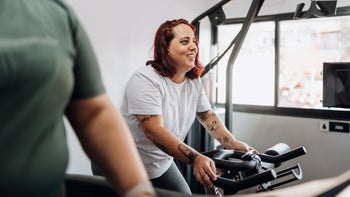
8 Tips for How to Prevent Shin Splints, Plus Stretches and Strengthening Exercises You Can Try
Key takeaways:
Repeated stress from activities such as running and jumping may increase your risk of shin splints. This common sports injury causes pain along the front of the lower leg.
Simple treatments, such as rest and cold therapy, can help shin splints heal.
If you’re prone to this type of injury, you can take steps, including stretching your calves and wearing supportive shoes, to prevent them.
Table of contents

Many athletes can tell you about the pain of shin splints, also known as medial tibial stress syndrome. This uncomfortable condition causes a dull, aching, or throbbing pain along the front of the lower leg. It’s common among runners and athletes who do activities involving running and jumping, which cause repeated stress on the shins.
Shin splints can make it difficult to stay active and achieve fitness goals. But preventative measures –– such as stretching and doing strengthening exercises –– can help you avoid this overuse injury.
How do you prevent shin splints?
Shin splints occur when the muscles, tendons, and tissue around the tibia become inflamed. The tibia is the larger of two bones that run from just beneath the knee to the ankle.
Search and compare options
Repetitive stress from high-impact activities such as running and dancing often causes shin splints. Other factors, such as increased exercise intensity and having flat feet, may also increase your risk of developing this injury.
Fortunately, you can do something about it. Here are eight proven tips for treating and preventing shin splints.
1. Stretch your calves and hamstrings
Stretching can help you keep shin splints at bay. Active warmup stretches increase blood flow to the muscles you'll use during your workout. So it's important to target your lower body –– especially your calves and hamstrings –– before high-impact activities that work your legs. Doing pre-run stretches such as side lunges is critical for having successful, injury-free runs, for example.
Passive stretches after your workout can relieve muscle tightness, which hinders your flexibility and mobility, increasing your risk of injury. For example, tight calves can limit your range of motion in your ankles. When this happens, your body may compensate by changing how your feet strike the ground when you run. And that change may increase stress on your ankles and shins.
Adding static hamstring and calf stretches to your cooldown can ease the symptoms of shin splints or prevent them altogether.
2. Strengthen your core and lower body muscles
Core-strengthening exercises can improve muscle stability and prevent shin splints. This includes moves that target your legs, as well as your hips, glutes, and other core muscles.
Read more like this
Explore these related articles, suggested for readers like you.
By strengthening these muscle groups, you can support proper posture and lower-body alignment, lowering your risk of shin splints. And a full-body strength-training routine may help you avoid other overuse injuries.
3. Focus on your form
Doing high-impact activities with improper form causes repeated stress on your body. So beginners should take time to perfect their form when they start an exercise routine.
Correct running form can reduce injuries and boost your performance. You can improve your form by focusing on factors such as posture and stride length. This can lessen running's impact on your shins and the surrounding muscles and joints. For example, a shorter running stride may reduce the load on the lower extremities.
4. Increase exercise intensity and frequency gradually
Doing too much of an activity too soon overloads your muscles and joints, increasing your risk of injuries such as shin splints. That's why fitness beginners are particularly susceptible to them.
Avoid this common exercise mistake by slowly increasing your training intensity and frequency. New runners, for example, should increase distance gradually. Progressive training will help build the endurance necessary for longevity and speed. And it helps prevent too much stress on your shin bones as your body adapts to increased physical activity.
5. Make time for rest
Shin splints are a repetitive use injury, so adequate downtime is important for healing and prevention. It gives your muscles, bones, and joints a break.
Make sure you take 2 to 3 rest days every week. This allows your body to recover and adapt to training. But rest days don't mean you should stop all physical activity. You can use your downtime for active recovery (more on that below).
6. Cross-train with lower-intensity activities
Cross-training allows you to include multiple types of exercise in your fitness plan. It's a great way to meet expert recommendations for weekly aerobic, strength-training, balance, and flexibility exercises. And it keeps your fitness routine fresh while helping you avoid repeated stress on the same muscle groups, which is key to preventing shin splints.
Your cross-training plan should include 1 to 2 days of active recovery or low-intensity activity, such as swimming, cycling, and yoga. This is important for everyone, especially athletes who play high-impact sports such as basketball or soccer. Low-impact workouts can help you stay active while reducing stress on your shins.
7. Wear supportive shoes
Wearing supportive shoes is crucial for proper foot alignment during exercise. Evidence shows that people with overpronation, or flat feet, may have double the risk of developing shin splints.
If you have flat feet, your arch is absent or collapses toward the ground. This makes it harder for your feet to absorb shock. And less shock absorption increases the impact on your shin bones during activities such as jumping or marching.
Supportive footwear reduces this stress by stabilizing your feet and ankles. Look for shoes with good arch support or shock-absorbing insoles, which can help prevent shin splints. And keep in mind that experts recommend replacing your running shoes every 300 to 500 miles. If you’re new to running, you can swap them out every 6 months.
8. Exercise on softer surfaces
Running on hard or uneven surfaces, such as pavement, increases the impact on your body. And it may cause shin splints or make symptoms worse. Try switching to softer surfaces such as grass, turf, or carpet to lessen the shock to your muscles, bones, and joints.
What stretches and exercises can help you prevent or heal shin splints?
Stretches and strengthening exercises can help you prevent or relieve shin splints. The moves outlined below are designed to increase range of motion, strengthen stabilizing muscles in your lower body, and improve alignment.
Doing these exercises while resting from running and other aggravating activities can aid recovery and help you return to your routine with less pain. But talk to your healthcare provider first, especially if you have lower leg pain.
Stretches for shin splints
The best stretches for shin splints should target lower leg muscles to release tension, increase flexibility, and improve function.
1. Seated calf stretch
The seated calf stretch engages the largest calf muscle (gastrocnemius) in the back of the lower leg and the anterior tibialis muscle in the front of the lower leg.
Step 1: Sit on the floor with your legs extended straight in front of you.
Step 2: Loop a long strap or towel around the sole of your right foot.
Step 3: Hold the ends of the strap and gently pull your foot toward your body. Keep your knee straight, feeling the stretch in your calf.
Step 4: Hold for 30 seconds, then rest.
Step 5: Repeat 3-5 times with your right leg, then switch to your left leg.
2. Soleus stretch
The soleus is the smaller of the two major calf muscles. It helps keep your shin stable while you’re walking or running. This standing soleus stretch allows you to isolate these smaller calf muscles.
Step 1: Stand in front of a wall, placing your palms on it at shoulder height.
Step 2: Step your right foot forward, just before the wall. Keep both heels flat on the floor with your toes pointed toward the wall.
Step 3: Bend both knees and lean forward, keeping your heels on the floor.
Step 4: Hold for 30 seconds, feeling the stretch in your left calf.
Step 5: Repeat 3-5 times on each side.
3. Standing ankle stretch (dorsiflexion)
This ankle stretch uses dorsiflexion –– or moving your toes back toward your shin –– to lengthen muscles and ligaments in the front and back of the lower leg. It may increase ankle mobility.
Step 1: Stand in front of a wall with your right foot in front of your left foot, about hip-width apart.
Step 2: Put the ball of your right foot on the wall, keeping your heel on the floor and your knee straight. You can place your palms against the wall for balance.
Step 3: Hold for 5-10 seconds before returning to the starting position.
Step 4: Aim for 2-3 sets of 10 repetitions on each side.
Exercises for shin splints
Exercises for shin splints help strengthen the leg muscles surrounding your shin as well as your core. Strong muscles support mobility, helping you move and exercise without injury.
1. Calf raises
Calf raises are a great way to build strength in your lower legs. Strong calves help absorb the shock of high-impact activities. That could mean less stress on your shins.
Step 1: Stand with your back straight and your arms at your sides. You can also hold a wall for extra support.
Step 2: Engage your core and lift your heels off the floor as high as you can.
Step 3: Squeeze your calf muscles and hold for a few seconds before lowering your heels to the floor.
Step 4: Repeat 10 times.
2. Heel walks
Heel walking targets the anterior tibialis and calf muscles, making it a great way to strengthen the front and back of your lower leg.
Step 1: Stand with your back straight and feet flat on the floor. Keep your hands at your sides or place them on your hips.
Step 2: Engage your core and lift your toes off the floor as high as you can while staying balanced.
Step 3: Keep your heels on the floor and your toes lifted as you walk 10-20 steps or as far as you can for 30 seconds.
Step 4: Lower your heels and rest for 10 seconds. Repeat 2-3 times.
3. Clamshells
The clamshell exercise activates the hips and glutes, which keep your joints aligned and help you stay balanced. Strengthening these muscles may prevent lower-leg injuries such as shin splints. After you master this move, you can increase the intensity by adding a resistance band around your thighs.
Step 1: Lie on your side with your knees bent at a 45-degree angle and your forearm resting on the floor. Make sure your hips are stacked on top of each other. Your feet and ankles should be touching.
Step 2: Engage your core by squeezing your belly button toward your spine.
Step 3: Keep your feet together and lift your top knee as high as possible without swaying your hips or pelvis (like a clamshell opening).
Step 4: Hold the position for 5-10 seconds.
Step 5: Relax and slowly lower your leg back to the starting position.
Step 6: Complete 20 repetitions on your right and left sides.
When should you see a healthcare provider for shin splints?
Most cases of shin splints resolve in 2 to 6 weeks with conservative treatment, such as rest from aggravating activities. But you should see a healthcare provider if your symptoms worsen or don't improve with at-home care.
You should also visit a provider if you notice any of the following symptoms in your legs or feet:
Cramping
Burning
Numbness
Tingling
Swelling
These may be signs of another condition.
The bottom line
High-impact activities, such as running or playing basketball, increase your risk of shin splints. This common overuse injury causes pain along your shin. But it doesn’t have to put a stop to your fitness routine. Preventative measures, such as stretching and strength training, can help you stave off shin splints.
Why trust our experts?



References
American Council on Exercise. (n.d.). Seated calf stretch.
Alaia, M. J. (2019). Shin splints. OrthoInfo | American Academy of Orthopaedic Surgeons.
Alencar, M., et al. (2019). A road map to effective muscle recovery. American College of Sports Medicine.
Arnold, M. J., et al. (2018). Common running injuries: Evaluation and management. American Family Physician.
Centers for Disease Control and Prevention. (2022). How much physical activity do adults need?
DareBee. (2015). Exercise library: Calf raises [Video]. YouTube.
Deshmukh, N. S., et al. (2022). Medial tibial stress syndrome: A review article. Cureus.
Folland, J. P., et al. (2017). Running technique is an important component of running economy and performance. Medicine & Science in Sports & Exercise.
Journal of Orthopaedic & Sports Physical Therapy. (2015). Running: Improving form to reduce injuries.
McClure, C. J., et al. (2023). Medial tibial stress syndrome. StatPearls.
Menéndez, C., et al. (2020). Medial tibial stress syndrome in novice and recreational runners: A systematic review. International Journal of Environmental Research and Public Health.
Merck Manuals. (2023). How to do the heel walking exercise [Video]. YouTube.
Moen, J. J., (2022). Foot and ankle conditioning program. OrthoInfo | American Academy of Orthopaedic Surgeons.
Rehab Hero. (2023). Wall calf stretch – soleus and gastrocnemius assisted stretch for ankle dorsiflexion [Video]. YouTube.
Selkowitz, D. M., et al. (2013). Which exercises target the gluteal muscles while minimizing activation of the tensor fascia lata? Electromyographic assessment using fine-wire electrodes. Journal of Orthopaedic & Sports Physical Therapy.
Sports Injury Clinic. (2011). Ankle exercise – soleus muscle stretch [Video]. YouTube.
Tolbert, T. A., et al. (2009). Treatment and prevention of shin splints. Strength and Conditioning Journal.
University of California, San Francisco Orthopaedic Institute. (n.d.). Ankle strengthening protocols.
Winkelmann, Z. K., et al. (2016). Risk factors for medial tibial stress syndrome in active individuals: An evidence-based review. Journal of Athletic Training.
Winters, M., et al. (2013). Treatment of medial tibial stress syndrome: A systematic review. Sports Medicine.



























